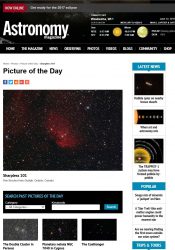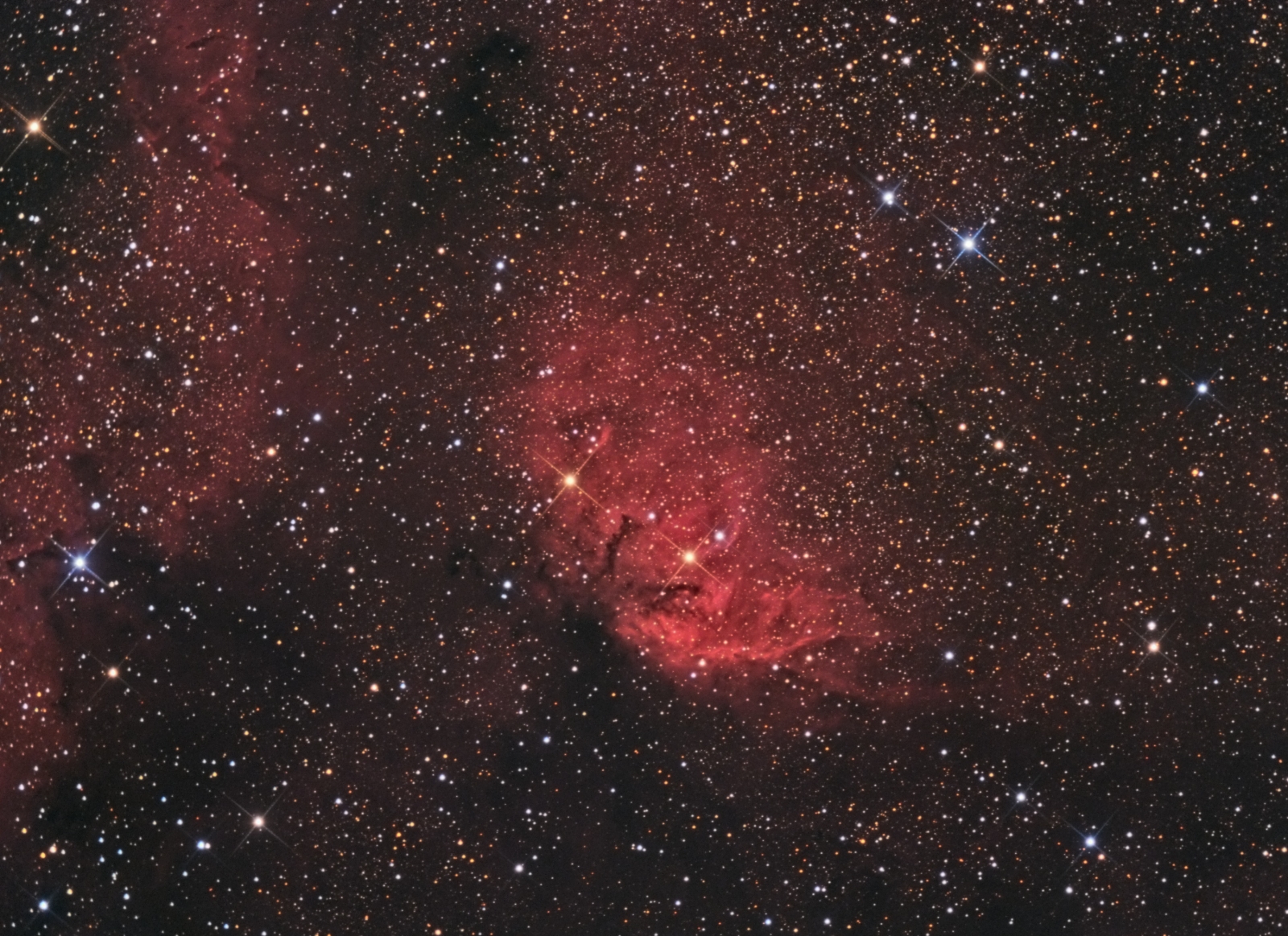Sh2-101, The Tulip Nebula
Click image for full size version
February 13, 2015; Astronomy Magazine Picture of the Day, June 5, 2017
 The main object in this image, Sh2-101, is also called the Tulip Nebula. It lies in Cygnus, not far from the Crescent nebula. Sh2-101 is about 6,000 light years away and lies in the rich star field of the Cygus Milky Way, so there are lots of colourful stars in this image. One of these is the visible companion to a black hole and X-ray source called Cygnus X-1. To find it, look 1/3 of the way from the bottom of the image near the right side for a pair of bright stars arranged vertically. The bottom one is Cygnus-X1. How cool is that?
The main object in this image, Sh2-101, is also called the Tulip Nebula. It lies in Cygnus, not far from the Crescent nebula. Sh2-101 is about 6,000 light years away and lies in the rich star field of the Cygus Milky Way, so there are lots of colourful stars in this image. One of these is the visible companion to a black hole and X-ray source called Cygnus X-1. To find it, look 1/3 of the way from the bottom of the image near the right side for a pair of bright stars arranged vertically. The bottom one is Cygnus-X1. How cool is that?
Tekkies:
SBIG STL-11000M camera, Baader LRGB and Ha filters, 10″ f/6.8 ASA astrograph, MI-250 mount. Guided with STL-11000’s external guider and 400 mm f.l. guide scope. Focusing with FocusMax. Acquisition, guiding and calibration with Maxim-DL. All processing in PixInsight. Shot from my SkyShed in Guelph, Ontario. Moonlight every night – near first quarter for R,G and B and near full for H-alpha. Average transparency and average seeing for RGB acquisition; good transparency and seeing for Ha acquisition.
22x10mHa, 14x3m R, 14x3m G, 7x3m B, all unbinned (Total 5hr25m).
Ha, R, G and B masters were cropped to remove edge artifacts from stacking. The R, G and B channels were combined to make an RGB image. Ha and RGB were processed with DBE, ColourCalibration was applied, and the Ha and RGB were combined with the NB-RGB script. HistogramTransformation was applied to get a pleasing image.
Synthetic Luminance:
Creation and cleanup: The R,G,B and Ha masters were combined using the ImageIntegration tool (average, additive with scaling, noise evaluation, iterative K-sigma / biweight midvariance, no pixel rejection). DBE was applied to neutralize the background.
Deconvolution: A star mask was made to use as a local deringing support. A copy of the image was stretched to use as a range mask. Regularized Richardson-Lucy Deconvolution was applied (75 iterations, external PSF made using DynamicPSF tool with about 30 stars).
Stretching: HistogramTransformation was applied to approximately match brightness of HaRGB’s L channel.
The luminance was extracted from the HaRGB image, processed and then added back into the HaRGB image as follows:
1. Extract luminance from the HaRGB image.
2. Apply LinearFit using the SynthL channel as a reference.
3. Use ChannelCombination in the Lab mode to replace the luminance of the HaRGB with the fitted luminance from step 2.
4. Use LRGBCombine to apply SynthL to the HaRGB image.
Additional Processing
Noise Reduction and Re-Stretch: TGVDenoise was applied in Lab mode with 300 iterations with a range mask used to protect nebula and stars. This was followed by a HistogramTransformation to raise the black point (but with no clipping).
Star Reduction and Colour Adjustment: Morphological transformation (3×3, 4 iterations, strength 0.15) was applied using a star mask to protect background and nebula. Luminance was extracted from the image and LinearMultiscaleTransform was applied to extract the first 4 wavelet layers (no residual). This image was used as a mask when applying ColourSaturation to boost colour in the star cores.
Final Steps: A contrast adjustment and colour saturation tweak was applied.
Image scale is about 1.1 arcsec per pixel for this camera / telescope combination.







The only criticism I have of this image is that it doesn’t include the xrays associated with Cygnus X-1 although this is a little out of the reach of amateurs! One other thing I love about this nebula is a bowshock around a star near the centre.